Twenty-Five Years (1992–2016) of Global Tsunamis: Statistical and Analytical Overview

The paper presents the analysis of global tsunami occurrence from 1992 to 2016. During this 25-year period, 290 tsunamis in marine basins and tsunami-like events in inland waters were registered. While this period represents less than 1% of the total catalog duration (ca. 4000 years), it contains almost 12% of the total number of historical events and nearly 54% of the total run-up and inundation depth measurements. The latter is mainly due to the data obtained in the field surveys of two trans-oceanic mega-tsunamis that occurred within this period—the December 26, 2004 Indian Ocean tsunami (1625 total measurements) and the March 11, 2011 Tohoku tsunami (6271 total measurements). Among 290 registered tsunamis and tsunami-like events, there were 95 damaging or potentially-damaging events that had maximum run-up or inundation height > 1 m and 32 destructive tsunamis that resulted in human fatalities. As throughout history, the Pacific continues to be the main tsunamigenic region with 223 events (77%) that occurred within its basin; 26 events (9%) occurred in the Indian Ocean, 26 events (9%) in the Atlantic, and 15 events (5%) in the Mediterranean region. Six tsunami-like events occurred in internal basins (rivers and lakes). The complete statistics of the recent tsunamis in the form of their distribution over type of sources, validity, fatalities and damaging effects, intensity, and warning efficiency are presented. The paper also outlines and discusses the existing problems with data compilation, cataloging and distribution, and discusses incompleteness of run-up and wave-form data for a considerable number of non-damaging tsunamis, even those resulting from strong (magnitude higher than 7.5) submarine earthquakes.
This is a preview of subscription content, log in via an institution to check access.
Access this article
Subscribe and save
Springer+ Basic
€32.70 /Month
- Get 10 units per month
- Download Article/Chapter or eBook
- 1 Unit = 1 Article or 1 Chapter
- Cancel anytime
Buy Now
Price includes VAT (France)
Instant access to the full article PDF.
Rent this article via DeepDyve
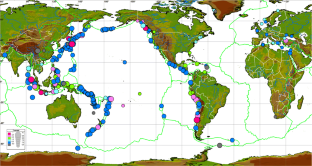
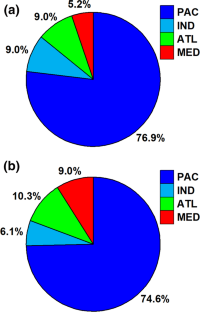
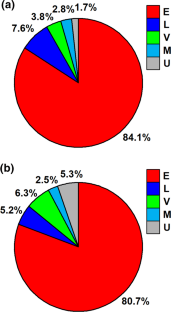
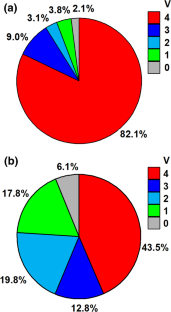
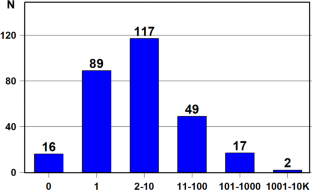
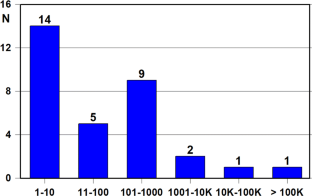
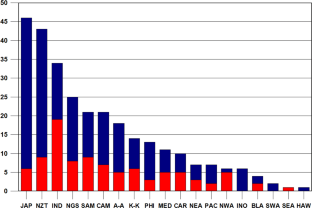
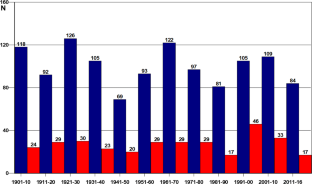
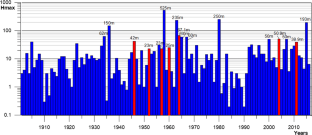
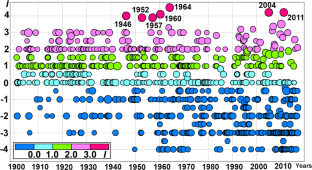
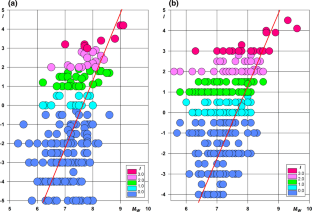
Similar content being viewed by others
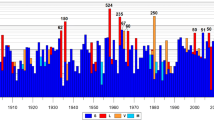
Global Occurrence of Large Tsunamis and Tsunami-like Waves Within the Last 120 years (1900–2019)
Article 10 February 2020
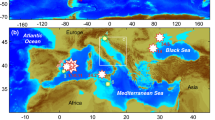
Twenty-Seven Years of Progress in the Science of Meteorological Tsunamis Following the 1992 Daytona Beach Event
Article 07 November 2019

Introduction to “Twenty Five Years of Modern Tsunami Science Following the 1992 Nicaragua and Flores Island Tsunamis, Volume I”
Article 01 July 2019
References
- Arcos, N.P., Dunbar, P.K., Stroker, K.J., & Kong, L.S.L. (2019). Post-tsunami surveys impact on the NCEI/WDS global historical tsunami database. Pure and Applied Geophysics, 176, (in press).
- Chubarov, L. B., & Gusiakov, V. K. (1985). Tsunamis and earthquake mechanism in the island arc region. Science of Tsunami Hazards,3(1), 3–21. Google Scholar
- Eblé, M. C., & González, F. I. (1991). Deep-ocean bottom pressure measurements in the Northeast Pacific. Journal of Atmospheric and Oceanic Technology,8, 221–233. ArticleGoogle Scholar
- Gusiakov, V.K. (2009). Tsunami History: Recorded. In: Bernard, E. N., & Robinson, A. R. (Eds.), The sea (pp. 23–53), 15.
- Gusiakov, V. K. (2011). Relationship of tsunami intensity to source earthquake magnitude as retrieved from historical data. Pure and Applied Geophysics,168(11), 2033–2041. https://doi.org/10.1007/s00024-011-0286-2. ArticleGoogle Scholar
- Intergovernmental Oceanographic Commission. (2014). Users guide for the Pacific Tsunami Warning Center enhanced products for the Pacific Tsunami Warning System, IOC Technical Series, 105 (Revised ed.). Paris: UNESCO/IOC.
- JMA (Japan Meteorological Agency) home page. 2019. https://www.data.jma.go.jp/svd/eqev/data/higai/higai-1995.html. Accessed 15 Jan 2019.
- Kanamori, H. (1972). Mechanism of tsunami earthquakes. Physics of the Earth and Planetary Interiors,6, 346–359. ArticleGoogle Scholar
- Kong, L. S. L., Dunbar, P. K., & Arcos, N. (Eds.). (2015). Pacific tsunami warning system: a half century of protecting the Pacific, 1965–2015. Honolulu: International Tsunami Information Center. Google Scholar
- NCEI/WDS Global Historical Tsunami Database, 2100 BC to Present (2018). https://doi.org/10.7289/v5pn93h7. Accessed 30 Nov 2018.
- NTL/ICMMG GTDB (Novosibirsk Tsunami Laboratory of the Institute of Computational Mathematics and Mathematical Geophysics of Siberian Division of Russian Academy of Sciences) 2100 BC to Present (2018). http://tsun.sscc.ru/nh/tsunami.php. Accessed 15 Dec 2018.
- PDM/TSU (Parametric Data Manager for Tsunami data management) graphic shell, NTL/ICMMG SD RAS. http://tsun.sscc.ru/PDM.htm. Accessed 15 Dec 2018.
- Soloviev, S. L. (1978). Basic data on tsunamis on the Pacific coast of the USSR, Izuchenie Tsunami v Otkrytom Okeane (pp. 61–135). Moscow: “Nauka” Publishing House. (in Russian). Google Scholar
- Soloviev, S. L., & Go, C. N. (1974). A catalogue of tsunamis on the western shore of the Pacific Ocean (p. 308). Moscow: “Nauka” Publishing House. (in Russian; English translation by the Canadian Institute for Scientific and Technical Information, No.5077, National Research Council, Ottawa, Canada, 1984, 439 pp.). Google Scholar
- Soloviev, S. L., & Go, C. N. (1975). A catalog of tsunamis on the eastern shore of the Pacific ocean. Moscow: Academy of Science of the USSR, Nauka Publishing House. (in Russian; English translation by the Canadian Institute for Science and Technical Information, No. 5078, National Research Council, Ottawa, Canada, 1984, 293 pp.). Google Scholar
- Tappin, D. R., Grilli, S. T., Harris, J. S., et al. (2014). Did a submarine landslide contribute to the 2011 Tohoku tsunami? Marine Geology,357, 344–361. ArticleGoogle Scholar
- Wielandt, E., & Streckeisen, G. (1982). The leaf spring seismometer: Design and performance. Bulletin of the Seismological Society of America,72(Part A), 2349–2367. Google Scholar
Acknowledgements
Some figures in the paper were drawn using procedures built in the PDM/TSU graphic shell (PDM/TSU 2018) developed in the NTL/ICMMG SD RAS as supporting software for GTDB maintenance. The authors wish to thank Fred Stephenson and Robert Geller for careful reading the manuscript and making numerous suggestions for its improvement as well as Tamara Kalashnikova for assistance in figures and tables preparation. The results presented in this paper were partly supported by the RFBR Grant 16-05-00450.
Author information
Authors and Affiliations
- Institute of Computational Mathematics and Mathematical Geophysics (ICMMG), Novosibirsk, Russia Viacheslav K. Gusiakov
- Cooperative Institute for Research in Environmental Sciences (CIRES), University of Colorado at Boulder, Boulder, USA Paula K. Dunbar & Nicolás Arcos
- NOAA National Centers for Environmental Information (NCEI), Asheville, USA Paula K. Dunbar & Nicolás Arcos
- Viacheslav K. Gusiakov















